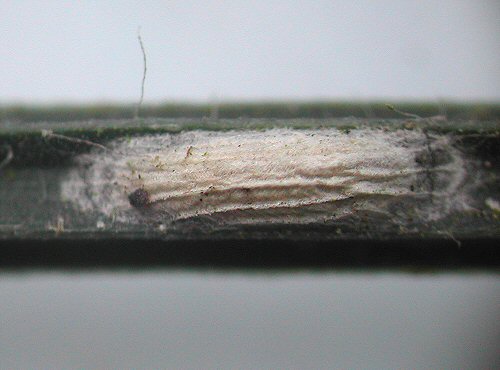|
||||||
|
Bucculatrix
ulmella Zeller, 1848 Oak Bent-wing
Bucculatrix
ulmella Zeller, 1848. Linn. Ent.
3: 288.
|
||||||||||||||||||||||||||||||||||||||||||||||||||||||||||||||||||||||||||||||
|
Leaf-miner: The mine is a short contorted gallery close to the midrib of a leaf, containing broken black frass (UKMoths). Egg at the upperside of the leaf, generally adjacent to the midrib. The mine is a short, angular corridor with much black frass and a relatively large larval chamber. The larvae soon leave their mines and start causing lower-surface window feeding Bladmineerders van Europa. The leaf-mine is also illustrated in British leafminers. Multiple mines can occur in the same leaf. Melissa Banthorpe found 14 mines in one leaf (see Facebook Group). Larva: The larvae of moths have a head capsule and chewing mouthparts with opposable mandibles (see video of a gracillarid larva feeding), six thoracic legs and abdominal legs (see examples). Head brown, pronotum grey with black punctuation (Hering, 1957a) (Bladmineerders van Europa. The larva is illustrated in UKMoths and British leafminers. Pupa: The pupae of moths have visible head appendages, wings and legs which lie in sheaths (see examples). When pupating, in common with other Bucculatrix species, the larva creates a distinctive ribbed cocoon surrounded by a 'palisade' of vertical silken hairs (UKMoths). The pupa and cocoon are illustrated in British leafminers.
Adult: The adult is illustrated in UKMoths by Rob Edmunds. The species is included in mothdissection.co.uk. Hosts in Great Britain and Ireland:
Hosts elsewhere:
Time of year - larvae: July, September - October (British leafminers). Time of year - adults: Currently unknown. Distribution in Great Britain and Ireland: A fairly common species in England, including Lancashire (Greater Manchester and Littleborough) (UKMoths) and Hampshire (Fleet and Hayling Island) (British leafminers), Wales and Scotland, though like many of its genus probably overlooked (UKMoths); Bedfordshire, Breconshire, Caernarvonshire, Cambridgeshire, Derbyshire, Dorset, Durham, East Kent, East Norfolk, East Suffolk, Glamorgan, Haddington, Huntingdonshire, Isle of Wight, Leicestershire, Merionethshire, Middlesex, North Hampshire, North Northumberland, Shropshire, South Aberdeenshire, South Devon, South Hampshire, South Northumberland, South Wiltshire, Stafford, Surrey, Warwickshire, West Cornwall, West Gloucestershire, West Lancashire, West Norfolk, West Suffolk, Westmorland and Worcestershire (NBN Atlas). See also British leafminers distribution map. Also recorded from Ireland (UKMoths and National Biodiversity Data Centre Map). Distribution elsewhere: Widespread in continental Europe including Austria, Belarus, Belgium, Croatia, Czech Republic, Danish mainland, Estonia, European Turkey, Finland, French mainland, Germany, Greek mainland, Hungary, Italian mainland, Latvia, Lithuania, Luxembourg, Macedonia, Norwegian mainland, Poland, Romania, Russia Central, East and Northwest, Sardinia, Sicily, Slovakia, Sweden, Switzerland, The Netherlands, Ukraine and Yugoslavia (Fauna Europaea). NBN Atlas links to known host species:
British and Irish Parasitoids in Britain and elsewhere:
|
||||||||||||||||||||||||||||||||||||||||||||||||||||||||||||||||||||||||||||||
| Last updated 13-Jul-2019 Brian Pitkin | ||

